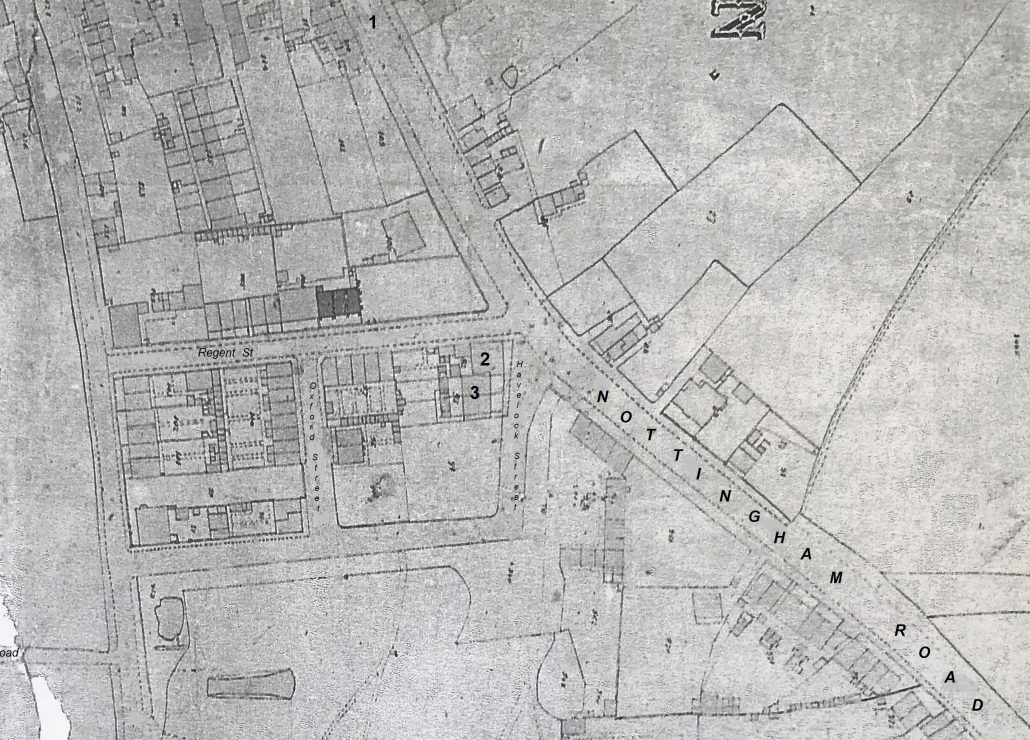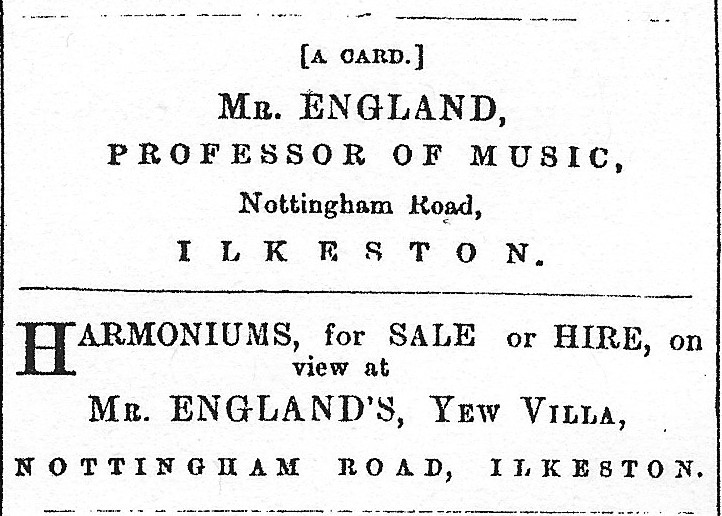Accident Alert: October 1st 1887
Travelling down Nottingham Road at a very rapid rate, close to the junction with Regent Street, William Ogden, a printer who lived in Station Road, turned round to nod to a chap he knew by the roadside. Not very clever !! He was pitched into the road, rescued and carried to a nearby house where he lay unconscious for several hours — despite the ministrations of his wife and Dr. Tobin. He recovered slowly.
The condition of his bicycle was not reported.
On the previous night, riding down Derby Road, a young lad named Daykin of West Hallam suffered a similar accident. The india rubber tyre on his front wheel came loose, causing the lad to be thrown over the handlebars. He sustained injuries to the head, neck and wrist.
More cyclists in more trouble: July 1895.
By this time cycling offences were becoming more common and proliferative. For example, in this July there was a list of such cyclists queuing up at Ilkeston Petty Sessions to hear their fate.
Frank Ward had no bell or whistle on his vehicle as he overtook a cart on the highway (as per the Local Government Act 1888) — merely shouting a warning was not compliant with the Act !!! — fined 2s 6d with 9s costs.
Henry Smith, riding behind Frank, committed the same offence at the same time — and got the same fine, but with 8s costs.
John Hall, riding down Bath Street, didn’t sound his bell — fined 2s 6d with 9s 6d costs.
Similarly, William Field, William Manners and James Shaw — fined similarly.
Herbert Keeling was riding his bike after dusk without a lighted lamp — fined 2s 6d with 9s 6d costs.
Evelyn Barker was riding furiously, within the sight of Inspector Savory — fined 7s 6d with 6s 6d costs
——————————————————————————————————————–
Leaving behind Stanton Road, we are now walking down the western side of the road, out of White Lion Square. The map below shows this area about 1866 (We start at the top, middle)
————————————————————————————————————————–
Joseph Harrison’s lodging house
Adeline remembers that “Joseph Harrison’s Lodging House was at the top of Nottingham Road”. (Look for number 1 on the map, at the top of Nottingham Road)
A licence to keep a lodging house for nine lodgers at 109 Nottingham Road was granted to Joseph Harrison by the Local Board in 1872. A lodger was defined as ‘a comer and goer’.
Joseph was the son of George, framework knitter of Park Road, and Elizabeth (nee Harrison), and in June 1859 married Eliza Bostock, daughter of Samuel, coalminer of Bath Street, and Sarah (nee Curtis).
At the same time similar lodging houses in Nottingham Road were kept by Sarah Marshall, William Burrows senior, James Quinn and Joseph Siddons.
————————————————————————————————————————–
Blind Joseph England
In the road leading to Hobson’s field and house was Baker Marshall’s shop, …. recalls Adeline
We have previously met William ‘Baker’ Marshall. (number 2 on the map)
also two houses built by Miss Sophia Wigley. (number 3 on the map)
Mr. England, the blind music teacher, lived in one.
Joseph England was born in Alfreton in 1840, the son of saddler Joseph and Frances Elizabeth (nee Mee) and thus was tied to the Haynes family of Station Road corner.
He was a leading performer for the Ilkeston Philharmonic Society whose first concert was given in December 1860. In that concert and presiding at the piano, he executed Talexi’s ‘Grand Military March’ in a masterly manner and showed taste and expression in rendering ‘Sunshine and cloud’ and ‘Excelsior’, for both of which he was ‘rapturously encored’. Such was the assessment of the Pioneer’s ‘music critic’.
In 1863, while now residing in Ilkeston, Joseph married Maria Brassington Mayer, youngest daughter of Samuel and Maria Prudence (nee Brassington).
Joseph advertised pianoforte and singing lessons at Bath Street premises, and harmoniums for sale or hire.
His residence in 1864-1865 was Yew Villa, Nottingham Road.
Adeline recalls a visit to a concert: “I was a scholar at the Cricket Ground Chapel and I remember going to a concert, when blind Mr. England, a music teacher in the town, was the pianist. I was seated in the front pew over the entrance and thoroughly enjoyed in my childish way watching Mr. England’s fingers travelling over the piano keys, and wondering, he being blind, how he found them all”.
“And no one can sing to the pews like Blind Joey E” (adapted from Bob Dylan).
Joseph was also an accomplished singer and took part in several local concerts in the 1860’s.
After one such concert held at the British School in 1864, where he sang Longfellow’s ‘Excelsior’ (music by Maria Lindsay), the Pioneer was drawn to admit ……
“We have heard this song both in public and in private, but never heard it with more genuine satisfaction than when listening to Mr. England”’.
It went on; “The music is quite within the compass of Mr. England’s voice, and was tastefully executed throughout. The youth’s progress up the Alpine height was watched with eager interest, and the singer’s modification of voice as the youth’s utterances were less and less distinctly heard, until the final whisper, gently falling upon the ear from far up the height, was artistically done and had a most telling effect. This song was loudly and deservedly encored”.
Joseph was accompanied on the piano by his wife.
If you have forgotten ‘Excelsior’, the poem begins…
The shades of night were falling fast,
As through an Alpine village passed
A youth, who bore, ‘mid snow and ice,
A banner with the strange device,
Excelsior!
At the beginning of 1868 a sale was advertised at Yew Villa, Nottingham Road and included items of Music Room furniture, a piano in rosewood, a very superior harmonium with two beds of keys and pedals and hand and foot blowers.
After living most of the 1860’s in Ilkeston the England family eventually moved to Hastings, Sussex, via Alfreton, about 1868 and there Joseph died, at the family home of 57 St Mary’s Terrace, in November 1870.
————————————————————————————————————————–
Mrs. Raynes
“Mrs. Raynes and her daughters (lived) in the other house” Adeline tells us.
Mrs Raynes was born Elizabeth Wild in 1819 at New Radford, Nottingham, the daughter of printer Henry and Rosanna (nee Shaw).
In 1850 she married Joseph Raynes junior, the son of Joseph and Lucretia (nee Shuttlewood), and who was born in Loughborough although the family moved to Nottingham where Joseph junior worked in the lace trade.
The family came to Ilkeston in the late 1850’s.
The 1861 census finds them living in South Street when Joseph was a worker at the Stanton ironworks. (See Gladstone Street to Weaver Row).
————————————————————————————————————————–
And now for more music, this time with the musical Wardles




